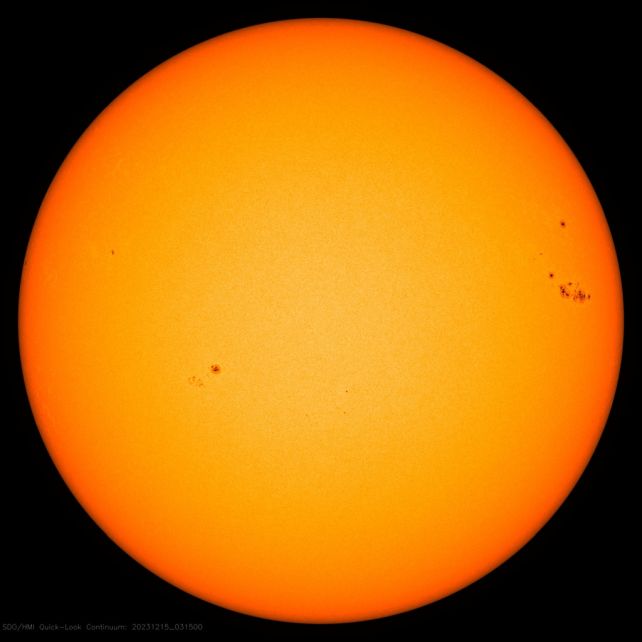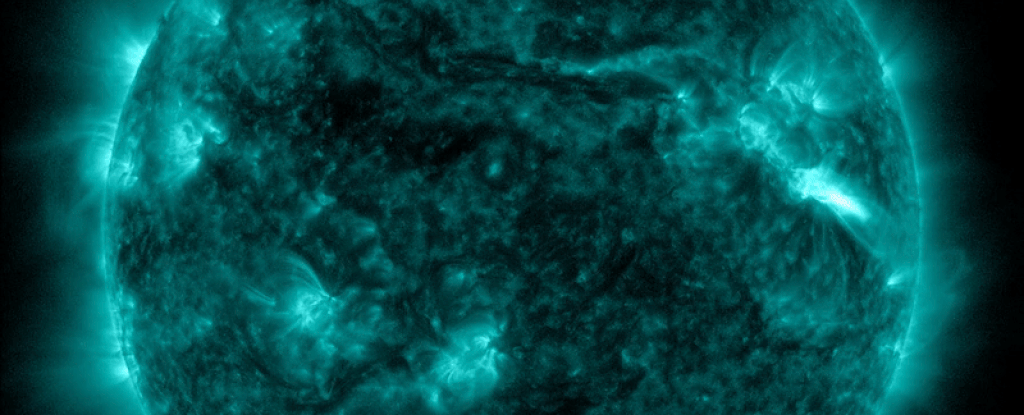The Sun has just belched out an absolute beast of a flare.
On 14 December, an active sunspot region named AR 3514 erupted in a class X2.8 solar flare, the most intense category of which our star is capable. The flare is the most powerful we’ve seen for the current solar cycle, and the most powerful since the X8.2 flare of September 2017.
The event produced a moderate radio blackout centered on South America, a temporary degradation or complete loss of radio signals in high frequencies, for two hours.
At the same time, the Sun produced a coronal mass ejection, or CME – an ejection of up to billions of tons of plasma and magnetic field, out into the Solar System, pelting anything in its path with solar particles.
And some of it may be headed for Earth. Agencies such as the NOAA are currently investigating; if it is, we may be in for a moderate geomagnetic storm.
Firstly, there’s no need for concern. Although the flare was powerful, it was not directly facing Earth, but slightly away, meaning that the blow could be a glancing one. Or it might not hit at all. Analysis is ongoing, but if it does hit, it’s expected on 17 December, according to the UK Met Office, possibly delivering a minor geomagnetic storm.
We may see some activity sooner, though. A weaker CME that erupted on 13 December will reach Earth first according to NOAA’s Space Weather Prediction Center.
Here’s what that means. A geomagnetic storm is what happens when an influx of solar particles slams into Earth’s magnetic field. Because thse particles take some time to get here, the storm occurs up to a few days after the CME is released.
This has several effects, which get more severe with the severity of the storm. There are five levels; G1 and G2, minor and moderate, are the two mildest categories.
As the solar particles interact with Earth’s magnetic field, they can create electrical currents that flow through power grids, so we may see some power grid fluctuations. There may be changes in the environment in low Earth orbit that alter the drag effect on spacecraft, meaning some satellites may need course corrections. And there may be interruptions to radio communications.

There’s also the possibility of aurora. A 10-point Kp index for geomagnetic activity can be used as a gauge to predict auroral activity.
The NOAA has predicted that geomagnetic activity will reach Kp5 on 15 and 16 December. This means that there will likely be a bright auroral display at high latitudes. You can check Spaceweatherlive’s aurora forecast to see when peaks will be occurring.
This sort of activity from the Sun is pretty normal. We’re reaching the peak of its 11-year activity cycle, which means more sunspots, more flares, and more CMEs. At the peak, known as solar maximum, the polarity of the Sun’s magnetic field will flip, and activity will start to subside. We don’t know precisely when solar maximum will occur; in fact, we likely won’t know until sometime after it has been and gone. Current predictions place it as early as January 2024.
AR 3514 has been a pretty active region. In addition to the X-class flare, it erupted in two M-class flares on the same day. That’s the second-most powerful category of solar flares. We may see more activity from it yet, but it’s not as likely to impact Earth; the region is currently rotating away from us, and will shortly disappear onto the far side of the Sun.
Not to worry, though. There’s bound to be plenty more before the current solar cycle is done.





